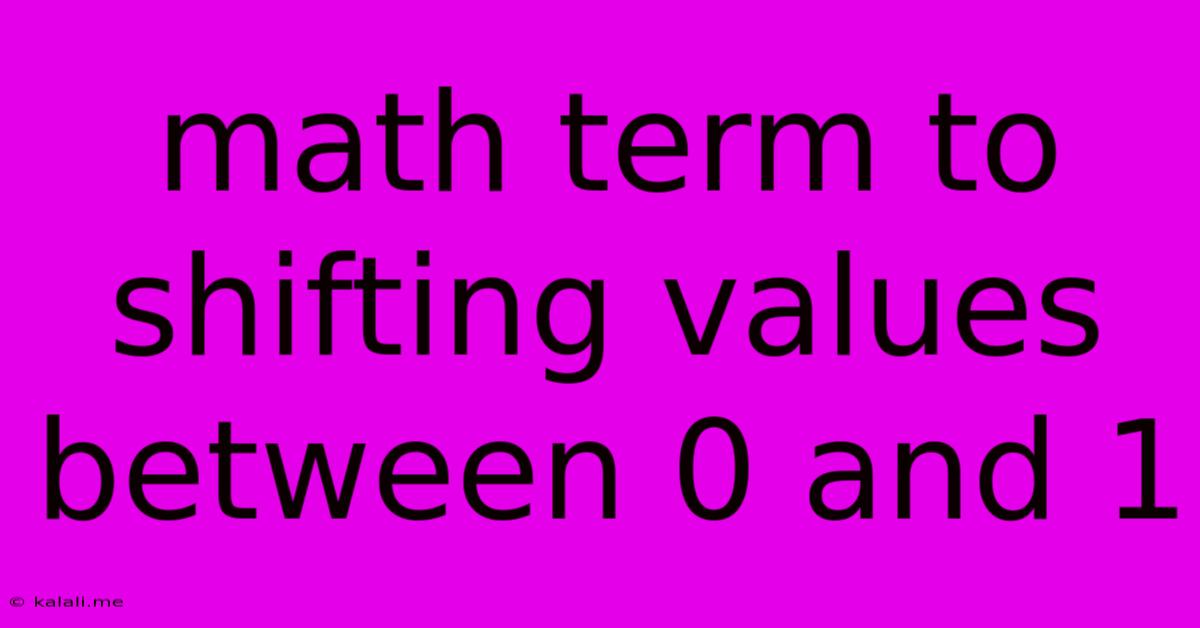Math Term To Shifting Values Between 0 And 1
Kalali
May 23, 2025 · 3 min read

Table of Contents
Math Terms for Shifting Values Between 0 and 1
This article explores mathematical functions and techniques used to map or shift values within the range of 0 and 1. This is a crucial concept in various fields like computer graphics, machine learning, signal processing, and probability, where normalization and scaling are frequently required. Understanding these methods helps in controlling and interpreting data within a standardized interval.
1. Linear Interpolation (Lerp)
The simplest approach is linear interpolation, often abbreviated as Lerp. This method creates a linear relationship between two values, smoothly transitioning between them. Given two values, a and b, and an interpolation factor t (ranging from 0 to 1), the Lerp function is defined as:
Lerp(a, b, t) = a + t * (b - a)
When t = 0, the result is a; when t = 1, the result is b. Values of t between 0 and 1 produce intermediate values along the line segment connecting a and b. Lerp is computationally inexpensive and widely used for basic value adjustments.
For example, if you want to smoothly transition a color value from red (a=0) to green (b=1) over a certain period, Lerp provides a straightforward way to achieve this by varying the t value over time.
2. Sigmoid Functions
Sigmoid functions are S-shaped curves that map any input value to a value between 0 and 1. They're particularly useful in machine learning for activating neurons or creating probability distributions. The most common sigmoid function is the logistic function:
Logistic(x) = 1 / (1 + exp(-x))
where exp represents the exponential function. As x approaches negative infinity, the output approaches 0; as x approaches positive infinity, the output approaches 1. The logistic function is smooth and differentiable, making it suitable for gradient-based optimization algorithms.
3. Step Functions
In contrast to smooth sigmoid functions, step functions provide a sharp transition between 0 and 1. A common example is the Heaviside step function (unit step function):
Heaviside(x) = 0 if x < 0, 1 if x >= 0
This function instantly switches from 0 to 1 at x=0. While simple, step functions are not differentiable at x=0, limiting their application in certain contexts that require smooth transitions.
4. ReLU (Rectified Linear Unit)
Used extensively in neural networks, the ReLU (Rectified Linear Unit) function is defined as:
ReLU(x) = max(0, x)
While it doesn't strictly map values to the 0-1 range, it can be combined with scaling and shifting techniques to achieve this. For instance, a modified version could be:
Modified ReLU(x) = min(1, max(0, x))
5. Normalization
Normalization is a broader technique to scale values from any range to the 0-1 range. A common method involves using the minimum and maximum values of a dataset:
Normalized Value = (Value - Min Value) / (Max Value - Min Value)
This approach transforms the data linearly, ensuring that the minimum value maps to 0 and the maximum value maps to 1. This is a vital step in preprocessing data for machine learning algorithms.
Choosing the right method depends on the specific application and desired properties. If smoothness is crucial, sigmoid functions are preferred. If a sharp transition is needed, step functions might suffice. For simple linear interpolation, Lerp is an efficient choice. For data preprocessing in machine learning, normalization techniques are fundamental. Understanding these various mathematical tools allows for effective manipulation and interpretation of data within a standardized 0-1 interval.
Latest Posts
Latest Posts
-
How Many Days Is 72 Hours From Tuesday
Jun 30, 2025
-
How Many Cups Are In 3 Quarts Of Water
Jun 30, 2025
-
25 Cents A Minute For An Hour
Jun 30, 2025
-
In Music What Does Allegro Mean Math Answer Key Pdf
Jun 30, 2025
-
What Is 1 5 Of A Tablespoon
Jun 30, 2025
Related Post
Thank you for visiting our website which covers about Math Term To Shifting Values Between 0 And 1 . We hope the information provided has been useful to you. Feel free to contact us if you have any questions or need further assistance. See you next time and don't miss to bookmark.